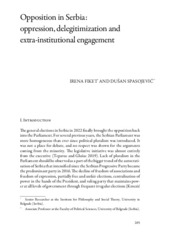Приказ основних података о документу
Opposition in Serbia: oppression, delegitimization and extra-institutional engagement
| dc.creator | Fiket, Irena | |
| dc.creator | Spasojevic, Dusan | |
| dc.date.accessioned | 2023-11-21T21:19:19Z | |
| dc.date.available | 2023-11-21T21:19:19Z | |
| dc.date.issued | 2023 | |
| dc.identifier.isbn | 978-88-5511-441-7 | |
| dc.identifier.uri | https://www.openstarts.units.it/server/api/core/bitstreams/bd1c886e-f6b5-408d-8b1a-66a4ffd3f095/content | |
| dc.identifier.uri | http://rifdt.instifdt.bg.ac.rs/123456789/3393 | |
| dc.description.abstract | this chapter analyses the opposition’s position and role in Serbia in its evolution since the introduction of pluralism and the collapse of the communist regime. We observe the opposition during the last 30 years from the two main aspects: institutional and ideational. We also provide an overview of the contextual factors to show some specificities of the post-socialist democratisation process and democratic backsliding in Serbia. The institutional elements we observed provide insight into the actors’ formal position and power; they show us the main mechanisms and resources at the opposition’s disposal and evaluate the possible inequalities or disbalances of powers between the actors. Conversely, the ideational aspect shows the dominant narratives and relationships between the opposition and position. These narratives reflect the understanding of democracy and the role the opposition should play in the political system. They also reflect changes over time and enable us to understand different concepts of democracy and democratisation. The chapter is divided into four sections, corresponding to four different phases reflecting specific circumstances and dynamics. The first phase is the Milošević decade (1990-2000), which covers the initial transitional period, characterised by severe authoritarian tendencies and societal conflicts during the Yugoslav break-up process. The second phase, that of democratisation (2000-2012), starts from the Milošević defeat and initial institutional development, throughout the first troubles in the democratic transition and riffs in the ruling coalition. The third phase (2012-2020) begins with the second turnover of power and optimism about social consensus and the consolidation of democracy. However, it develops into competitive authoritarianism and almost complete annulation of pluralism. The final phase is short (so far) and ongoing – defined by the protest waves, boycotts of elections and Parliament, and the return of the opposition in the institutions. | sr |
| dc.language.iso | en | sr |
| dc.publisher | EUT Edizioni Università di Trieste | sr |
| dc.rights | openAccess | sr |
| dc.rights.uri | https://creativecommons.org/licenses/by/4.0/ | |
| dc.source | The legal and political conditions of opposition parties in Central and Eastern Europe. An overview | sr |
| dc.title | Opposition in Serbia: oppression, delegitimization and extra-institutional engagement | sr |
| dc.type | bookPart | sr |
| dc.rights.license | BY | sr |
| dc.rights.holder | Fiket Irena | sr |
| dc.type.version | publishedVersion | sr |
| dc.identifier.fulltext | http://rifdt.instifdt.bg.ac.rs/bitstream/id/11711/bitstream_11711.pdf | |
| dc.identifier.rcub | https://hdl.handle.net/21.15107/rcub_rifdt_3393 |

